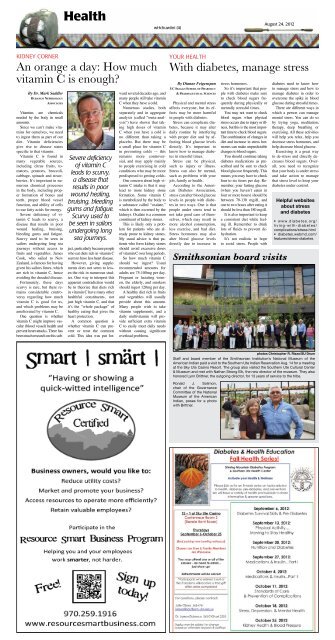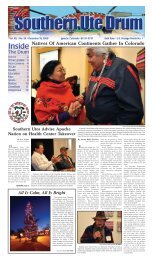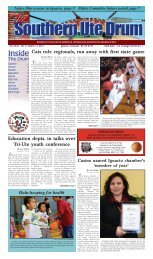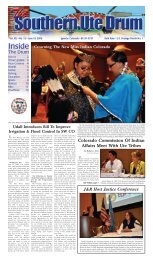August 24, 2012 - Southern Ute Indian Tribe
August 24, 2012 - Southern Ute Indian Tribe
August 24, 2012 - Southern Ute Indian Tribe
Create successful ePaper yourself
Turn your PDF publications into a flip-book with our unique Google optimized e-Paper software.
Health<br />
wHchuwiini (4)<br />
<strong>August</strong> <strong>24</strong>, <strong>2012</strong><br />
KIDNEY CORNER<br />
An orange a day: How much<br />
vitamin C is enough?<br />
By Dr. Mark Saddler<br />
Durango Nephrology<br />
Associates<br />
Severe deficiency<br />
of vitamin C<br />
leads to scurvy,<br />
a disease that<br />
results in poor<br />
wound healing,<br />
bruising, bleeding<br />
gums and fatigue.<br />
Scurvy used to<br />
be seen in sailors<br />
undergoing long<br />
sea journeys.<br />
Vitamins are chemicals<br />
needed by the body in small<br />
amounts.<br />
Since we can’t make vitamins<br />
for ourselves, we need<br />
to ingest them as part of our<br />
diet. Vitamin deficiencies<br />
give rise to disease states<br />
specific to that vitamin.<br />
Vitamin C is found in<br />
many vegetable sources,<br />
including citrus fruits, tomatoes,<br />
potatoes, broccoli,<br />
cabbage, spinach and strawberries.<br />
It’s important in numerous<br />
chemical processes<br />
in the body, including proper<br />
formation of bones and<br />
teeth, proper blood vessel<br />
function, and ability of cells<br />
to use fatty acids for energy.<br />
Severe deficiency of vitamin<br />
C leads to scurvy, a<br />
disease that results in poor<br />
wound healing, bruising,<br />
bleeding gums and fatigue.<br />
Scurvy used to be seen in<br />
sailors undergoing long sea<br />
journeys without access to<br />
fruits and vegetables. James<br />
Cook, who sailed to New<br />
Zealand, is famous for having<br />
given his sailors limes, which<br />
are rich in vitamin C, hence<br />
avoiding the dreaded disease.<br />
Fortunately, these days<br />
scurvy is rare, but there remains<br />
considerable controversy<br />
regarding how much<br />
vitamin C is good for us,<br />
and which problems may be<br />
ameliorated by vitamin C.<br />
One question is whether<br />
vitamin C might improve vascular<br />
(blood vessel) health and<br />
prevent heart attacks. There has<br />
been much research on this subject,<br />
particularly because people<br />
who eat diets rich in vitamin C<br />
seem to have less heart disease.<br />
However, giving supplements<br />
does not seem to lessen<br />
the risk in numerous studies.<br />
One way to interpret this<br />
apparent contradiction would<br />
be to theorize that diets rich<br />
in vitamin C have many other<br />
healthful constituents, not<br />
just high vitamin C, and that<br />
it’s the “whole package” of<br />
healthy eating that gives the<br />
heart protection.<br />
A common question is<br />
whether vitamin C can prevent<br />
or treat the common<br />
cold. This idea was put forward<br />
several decades ago, and<br />
many people still take vitamin<br />
C when they have a cold.<br />
Numerous studies, both<br />
separately and in aggregate<br />
analysis (called “meta-analysis”)<br />
have shown that taking<br />
high doses of vitamin<br />
C when you have a cold is<br />
no different than taking a<br />
placebo. But there may be<br />
a small place for vitamin C<br />
in preventing colds — this<br />
remains more controversial,<br />
and may apply mainly<br />
to people exercising in cold<br />
conditions who may be more<br />
predisposed to getting colds.<br />
One concern about high vitamin<br />
C intake is that it may<br />
lead to more kidney stone<br />
formation. Some vitamin C<br />
is metabolized by the body to<br />
a substance called “oxalate,”<br />
which is then excreted by the<br />
kidneys. Oxalate is a common<br />
constituent of kidney stones.<br />
This is likely only a problem<br />
for patients who are already<br />
prone to kidney stones.<br />
My usual advice is that patients<br />
who form kidney stones<br />
should avoid excessive doses<br />
of vitamin C over long periods.<br />
So how much vitamin C<br />
should we ingest? Usual<br />
recommended amounts for<br />
adults are 75-100mg per day.<br />
Pregnant or lactating women,<br />
the elderly, and smokers<br />
should ingest 120mg per day.<br />
A healthy diet rich in fruits<br />
and vegetables will usually<br />
provide about this amount.<br />
Many people wish to take<br />
vitamin supplements, and a<br />
daily multivitamin will provide<br />
sufficient extra vitamin<br />
C to easily meet daily needs<br />
without causing significant<br />
overload problems.<br />
YOUR HEALTH<br />
With diabetes, manage stress<br />
By Dianne Feigenspan<br />
UC Skaggs School of Pharmacy<br />
& Pharmaceutical Sciences<br />
Physical and mental stress<br />
affects everyone, but its effects<br />
may be more harmful<br />
in people with diabetes.<br />
Stress can complicate diabetes,<br />
because it may alter<br />
daily routine by interfering<br />
with proper diet and by affecting<br />
blood glucose levels<br />
directly. It’s important to<br />
know how to manage diabetes<br />
in stressful times.<br />
Stress can be physical,<br />
such as injury or illness.<br />
Stress can also be mental,<br />
such as problems with your<br />
job, family or health.<br />
According to the American<br />
Diabetes Association,<br />
stress can alter blood glucose<br />
levels in people with diabetes<br />
in two ways. One is that<br />
people under stress tend to<br />
not take good care of themselves,<br />
which may result in<br />
more alcohol consumption,<br />
less exercise, and bad diet.<br />
Stress hormones may also<br />
alter blood glucose levels<br />
directly due to increase in<br />
stress hormones.<br />
So it’s important that people<br />
with diabetes make sure<br />
to check blood sugars frequently<br />
during physically or<br />
mentally stressful times.<br />
You may not want to check<br />
blood sugars when physical<br />
stress occurs due to injury or illness,<br />
but this is the most important<br />
time to check blood sugars.<br />
The combination of changes in<br />
diet and increase in stress hormones<br />
can make unpredictable<br />
changes to blood sugars.<br />
You should continue taking<br />
diabetes medications as prescribed<br />
and be sure to check<br />
blood glucose frequently. This<br />
means you may have to check<br />
four to six times per day. Remember,<br />
your fasting glucose<br />
(when you haven’t eaten in<br />
four or more hours) should be<br />
between 70-130 mg/dl, and<br />
one to two hours after eating it<br />
should be less than 180 mg/dl.<br />
It is also important to keep<br />
a consistent diet while feeling<br />
ill. Remember to drink<br />
lots of fluids to prevent dehydration.<br />
It’s not realistic to hope<br />
to avoid stress. People with<br />
Smithsonian board visits<br />
diabetes need to know how<br />
to manage stress and how to<br />
manage diabetes in order to<br />
overcome the spike in blood<br />
glucose during stressful times.<br />
There are different ways in<br />
which a person can manage<br />
mental stress. You can do so<br />
by trying yoga, meditation,<br />
therapy, deep breathing or<br />
exercising. All these activities<br />
will help you relax, help you<br />
decrease stress hormones, and<br />
help decrease blood glucose.<br />
Exercising is a great way<br />
to de-stress and directly decreases<br />
blood sugars. Overall,<br />
you need to recognize<br />
that your body is under stress<br />
and take action to manage<br />
that stress level to keep your<br />
diabetes under control.<br />
Helpful websites<br />
about stress<br />
and diabetes<br />
• www.diabetes.org/<br />
living-with-diabetes/<br />
complications/stress.html<br />
• diabetes.webmd.com/<br />
features/stress-diabetes<br />
photos Christopher R. Rizzo/SU Drum<br />
Staff and board member of the Smithsonian Institution’s National Museum of the<br />
American <strong>Indian</strong> paid a visit to the <strong>Southern</strong> <strong>Ute</strong> <strong>Indian</strong> Reservation Aug. 14 for a meeting<br />
at the Sky <strong>Ute</strong> Casino Resort. The group also visited the <strong>Southern</strong> <strong>Ute</strong> Cultural Center<br />
& Museum and met with Nathan Strong Elk, the new director of the museum. They also<br />
honored Lynn Brittner, the outgoing director, for 13 years of service to the tribe.<br />
Ronald J. Solimon,<br />
chair of the Governance<br />
Committee of the National<br />
Museum of the American<br />
<strong>Indian</strong>, poses for a photo<br />
with Brittner.
















